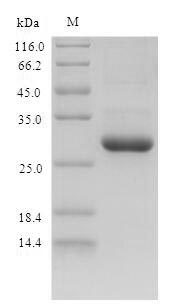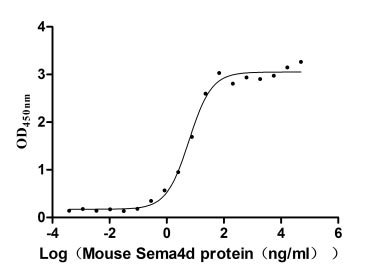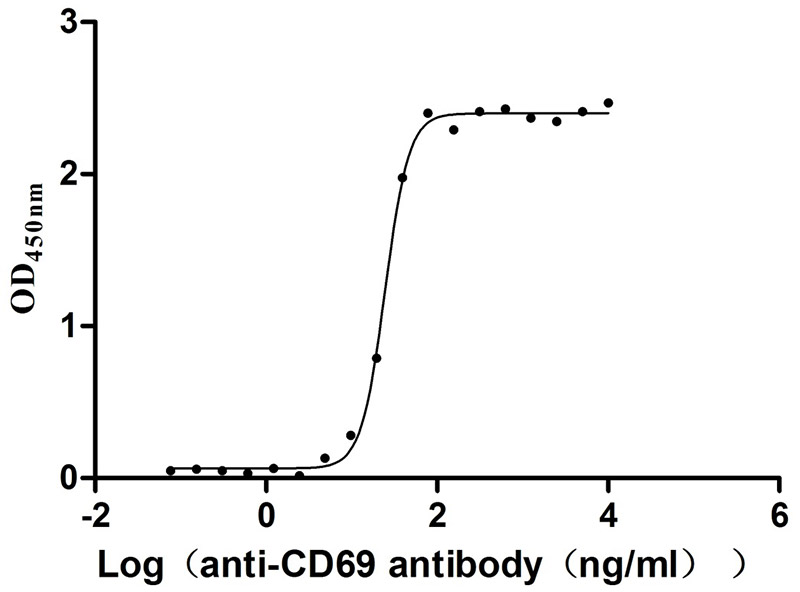Recombinant Mouse Protein S100-A9 (S100a9)
-
中文名称:小鼠S100a9重组蛋白
-
货号:CSB-EP020642MO
-
规格:¥1836
-
图片:
-
其他:
产品详情
-
纯度:Greater than 90% as determined by SDS-PAGE.
-
基因名:
-
Uniprot No.:
-
别名:S100a9; Cagb; Mrp14; Protein S100-A9; Calgranulin-B; Leukocyte L1 complex heavy chain; Migration inhibitory factor-related protein 14; MRP-14; p14; S100 calcium-binding protein A9
-
种属:Mus musculus (Mouse)
-
蛋白长度:Full Length of Mature Protein
-
来源:E.coli
-
分子量:28.9kDa
-
表达区域:2-113aa
-
氨基酸序列ANKAPSQMERSITTIIDTFHQYSRKEGHPDTLSKKEFRQMVEAQLATFMKKEKRNEALINDIMEDLDTNQDNQLSFEECMMLMAKLIFACHEKLHENNPRGHGHSHGKGCGK
Note: The complete sequence including tag sequence, target protein sequence and linker sequence could be provided upon request. -
蛋白标签:N-terminal 6xHis-SUMO-tagged
-
产品提供形式:Liquid or Lyophilized powder
Note: We will preferentially ship the format that we have in stock, however, if you have any special requirement for the format, please remark your requirement when placing the order, we will prepare according to your demand. -
缓冲液:Tris-based buffer,50% glycerol
-
储存条件:Store at -20°C/-80°C upon receipt, aliquoting is necessary for mutiple use. Avoid repeated freeze-thaw cycles.
-
保质期:The shelf life is related to many factors, storage state, buffer ingredients, storage temperature and the stability of the protein itself.
Generally, the shelf life of liquid form is 6 months at -20°C/-80°C. The shelf life of lyophilized form is 12 months at -20°C/-80°C. -
货期:Basically, we can dispatch the products out in 1-3 working days after receiving your orders. Delivery time may differ from different purchasing way or location, please kindly consult your local distributors for specific delivery time.Note: All of our proteins are default shipped with normal blue ice packs, if you request to ship with dry ice, please communicate with us in advance and extra fees will be charged.
-
注意事项:Repeated freezing and thawing is not recommended. Store working aliquots at 4°C for up to one week.
-
Datasheet & COA:Please contact us to get it.
相关产品
靶点详情
-
功能:S100A9 is a calcium- and zinc-binding protein which plays a prominent role in the regulation of inflammatory processes and immune response. It can induce neutrophil chemotaxis, adhesion, can increase the bactericidal activity of neutrophils by promoting phagocytosis via activation of SYK, PI3K/AKT, and ERK1/2 and can induce degranulation of neutrophils by a MAPK-dependent mechanism. Predominantly found as calprotectin (S100A8/A9) which has a wide plethora of intra- and extracellular functions. The intracellular functions include: facilitating leukocyte arachidonic acid trafficking and metabolism, modulation of the tubulin-dependent cytoskeleton during migration of phagocytes and activation of the neutrophilic NADPH-oxidase. Activates NADPH-oxidase by facilitating the enzyme complex assembly at the cell membrane, transferring arachidonic acid, an essential cofactor, to the enzyme complex and S100A8 contributes to the enzyme assembly by directly binding to NCF2/P67PHOX. The extracellular functions involve proinflammatory, antimicrobial, oxidant-scavenging and apoptosis-inducing activities. Its proinflammatory activity includes recruitment of leukocytes, promotion of cytokine and chemokine production, and regulation of leukocyte adhesion and migration. Acts as an alarmin or a danger associated molecular pattern (DAMP) molecule and stimulates innate immune cells via binding to pattern recognition receptors such as Toll-like receptor 4 (TLR4) and receptor for advanced glycation endproducts (AGER). Binding to TLR4 and AGER activates the MAP-kinase and NF-kappa-B signaling pathways resulting in the amplification of the proinflammatory cascade. Has antimicrobial activity towards bacteria and fungi and exerts its antimicrobial activity probably via chelation of Zn(2+) which is essential for microbial growth. Can induce cell death via autophagy and apoptosis and this occurs through the cross-talk of mitochondria and lysosomes via reactive oxygen species (ROS) and the process involves BNIP3. Can regulate neutrophil number and apoptosis by an anti-apoptotic effect; regulates cell survival via ITGAM/ITGB and TLR4 and a signaling mechanism involving MEK-ERK. Its role as an oxidant scavenger has a protective role in preventing exaggerated tissue damage by scavenging oxidants. The iNOS-S100A8/A9 transnitrosylase complex is proposed to direct selective inflammatory stimulus-dependent S-nitrosylation of multiple targets such as GAPDH, NXA5, EZR, MSN and VIM by recognizing a [IL]-x-C-x-x-[DE] motif.
-
基因功能参考文献:
- These results suggest that immunological functions of MRP14, and possibly also the associated molecule MRP8, are different between BALB/c and C57BL/6 mice, at least in the response to LPS. PMID: 29253495
- the biologically potent dimeric form of S100A9 is induced in vivo in situations of tumor burden or inflammatory challenge. PMID: 29679568
- findings reveal unexpected gene expression differences between WT and KO mice at a young age (in the absence of physiological stress), and address the hypothesis that Mrp8 and Mrp14 accumulation promotes age-related inflammation PMID: 27224926
- An excessive expansion of monocytic-myeloid-derived suppressor cells in S100A9-/- neonates compared to wild-type neonates. This strong baseline expansion was associated with hyperinflammatory responses during endotoxemia and fatal septic courses PMID: 27993995
- Data support a role of S100A9 to initiate and amplify the neutrophilic inflammation in asthma, possibly via inducing IL-1beta, IL-17 and IFN-gamma. PMID: 28847516
- S100A9 knockdown almost completely abrogated the effects of IRF7 deletion on granulocytic myeloid-derived suppressor cells development and tumor metastasis. PMID: 28092673
- vitro studies on the mechanisms/pathways involved in leukemic cell differentiation revealed that binding of S100A9 to Toll-like receptor 4 (TLR4) promotes activation of p38 mitogen-activated protein kinase, extracellular signal-regulated kinases 1 and 2, and Jun N-terminal kinase signaling pathways, leading to myelomonocytic and monocytic AML cell differentiation. PMID: 28137827
- these results indicate that CD14 is a co-receptor of TLR4 in the S100A9-induced cytokine response. PMID: 27228163
- Mechanistic studies showed that in MDSCs, ATF3 was transrepressed by the GC receptor GR through direct binding to the negative GR-response element. S100A9 is the major transcriptional target of ATF3 in Granulocytic Myeloid-derived Suppressor Cells. PMID: 27573240
- CHI3L1-mediated cell proliferation/survival involves partial downregulation of the pro-apoptotic S100A9 protein that is highly expressed during the acute phase of colitis, by binding to the S100A9 receptor, RAGE (Receptor for Advanced Glycation End products). PMID: 26431492
- MRP8/14 serves in an unexpected protective role for the lung in staphylococcal pneumonia. PMID: 25792636
- Canonical Wnt signaling was decreased after induction of experimental OA in S100A9-deficient mice. PMID: 26360647
- In a model of liver injury induced hepatocellular carcinoma, mice lacking S100A9 express reduced neutrophil chemokines and are protected from HCC. PMID: 25879839
- Data indicate that calgranulin B (S100A9) is essential for in vivo toll like receptor 3 (TLR3) signaling. PMID: 26385519
- Myocardial gene and protein expression of S100A9 was also significantly increased in mice 1 day after debanding that had been preceded by 3 days or 1 week of transverse aortic constriction. PMID: 25820336
- Identified TLR2 and S100A8/S100A9 as key regulators of hepatic CXCL-2 expression and neutrophil recruitment. PMID: 24333183
- Data shows that S100A9 protein is not required for liver tumors to form although it is highly upregulated in liver cancers. PMID: 25331529
- The mechanism of S100A9 is able to coincide with the inflammatory process. PMID: 24586443
- S100A9, potentially with its partner S100A8, makes a major contribution in the host response to pneumococcal infection by increasing circulating neutrophils principally regulation of G-CSF production. PMID: 24776746
- data identify a molecular pathway of thrombosis that involves platelet MRP-14 and CD36 and suggest that targeting MRP-14 has potential for treating atherothrombotic disorders, including MI and stroke. PMID: 24691441
- The endogenous TLR-4 ligand Mrp8/14 has a pro-inflammatory role to a regulatory function in adaptive immunity. PMID: 23188082
- Elevated S100A9 expression in colonic epithelial cells mediated by an IL-6/STAT3 signaling cascade may play an important role in the development of colitis. PMID: 22962574
- S100A9 and TLR4 appear to be involved in promoting tumor growth in two different tumor models and pharmacological inhibition of S100A9-TLR4 interactions is a novel and promising target for anti-tumor therapies. PMID: 22470535
- The absence of MRP-14 markedly increased T-cell activation and exacerbated allograft rejection, indicating a previously unrecognized role for MRP-14 in immune cell biology. PMID: 22144572
- S100A9 expression in nonmyeloid cells is likely to contribute to atherosclerosis. PMID: 21382888
- Neutrophil-derived protein S100A9 is a key player in the suppression of pro-inflammatory activation of macrophages. PMID: 19656587
- results suggest that S100a9 induced by Abeta or CT contributes to cause inflammation, which then affects the neuropathology including amyloid plaques burden and impairs cognitive function PMID: 20098622
- Upregulation and signaling of Mrp-8 and-14 contribute to neuroinflammation and the progression of ischemic damage. PMID: 19835955
- MRP-14(-/-) mice showed no obvious phenotype and similar induced inflammatory response but myeloid cells were less dense. MRP-14 and MRP-8 are apparently dispensable for many myeloid cell functions PMID: 12640137
- S100A9 plays a role in the inflammatory response to lipopolysaccharide by inducing the release of neutrophils from the bone marrow and directing their migration to the inflammatory site. PMID: 12928412
- MRP14 deficient mice show a diminished recruitment of granulocytes into the granulation tissue during wound healing in vivo. PMID: 15331440
- the C-terminus of S100A9 protein has a modulator effect on the function of adherent peritoneal cells PMID: 15953992
- This study defines a lesion in S100A9 null neutrophils associated with inflammatory agonist-induced IP3-mediated Ca2+ release that is manifested at the level of PLCbeta. PMID: 16814379
- These data demonstrate that the C-terminus of S100A9 protein interferes with control mechanisms of inflammatory pain. PMID: 16920226
- Bronchoalveolar lavage fluid protein S100A9 is cleaved by matrix metalloproteinases 2 and 9 and is essential for regulating inflammatory pathways in experimental asthma. PMID: 17082650
- Report showed S100A9 was expressed murine bone and cartilage cells and may contribute to calcification of the cartilage matrix and its replacement with trabecular bone, and to regulation of redox in bone resorption. PMID: 17636430
- During the early phase of an experimental streptococcal lung infection model, antimicrobial protein S100A9 is expressed in pneumocytes and may play a critical role in regulating innate immunity and transepithelial migration of macrophages and neutrophils. PMID: 18292562
- The delay in neutrophil recruitment in F. tularensis subsp. novicida-infected mice correlates with upregulation of cytokines, bacteremia, and release of high-mobility group box-1 and S100A9. PMID: 18411294
- Data show that the degree of intrapancreatic trypsinogen activation is influenced by the extent of leukocyte infiltration into the pancreas which, in turn, depends on the presence of S100A9 that is secreted from polymorph nuclear leukocytes. PMID: 18452188
- RAGE, carboxylated glycans and S100A8/A9 play essential roles in tumor-stromal interactions, leading to inflammation- PMID: 18689872
- Regardless of their in vivo location, myeloid-derived suppressor cells synthesize and secrete the inflammatory mediator S100A9 that accumulates in the serum of tumor-bearing mice. PMID: 18802069
- This study demonstrates that tumor-induced up-regulation of S100A9 protein is critically important for accumulation of myeloid-derived suppressor cells and reveals a novel molecular mechanism of immunological abnormalities in cancer. PMID: 18809714
- S100A9 is upregulated after arylhydrocarbon receptor activation and involved in thymocyte emigration. PMID: 16114106
显示更多
收起更多
-
亚细胞定位:Secreted. Cytoplasm. Cytoplasm, cytoskeleton. Cell membrane; Peripheral membrane protein.
-
蛋白家族:S-100 family
-
数据库链接:
KEGG: mmu:20202
STRING: 10090.ENSMUSP00000070842
UniGene: Mm.2128
Most popular with customers
-
Recombinant Mouse Semaphorin-4D (Sema4d), partial (Active)
Express system: Mammalian cell
Species: Mus musculus (Mouse)
-
Recombinant Human Early activation antigen CD69 (CD69), partial (Active)
Express system: Mammalian cell
Species: Homo sapiens (Human)
-
Recombinant Human CUB domain-containing protein 1 (CDCP1), partial (Active)
Express system: Mammalian cell
Species: Homo sapiens (Human)
-
Recombinant Macaca fascicularis C-type lectin domain family 4 member C(CLEC4C), partial (Active)
Express system: Mammalian cell
Species: Macaca fascicularis (Crab-eating macaque) (Cynomolgus monkey)
-
Recombinant Human Tumor necrosis factor ligand superfamily member 15(TNFSF15) (Active)
Express system: Mammalian cell
Species: Homo sapiens (Human)







-AC1.jpg)










